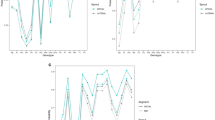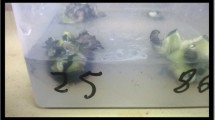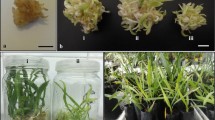Summary
The possibility of producing agronomically-useful somaclones via organogenesis and somatic embryogenesis from callus cultures of pea (Pisum sativum L.) was studied. Organogenic calli were induced from immature leaflets on MSB medium with NAA and BAP. Embryogenic calli were derived either from immature zygotic embryos (using 2,4-D) or from shoot apices (using picloram) of aseptically-germinated seedlings.
The seed progenies (T1 to T3-generation) of primary regenerants were grown in field conditions and their phenotypic variation was evaluated and compared with control, non-tissue culture-derived plant material. In addition, electrophoretic analyses of selected isoenzyme systems and total proteins have been done. The results do not show dramatic changes in qualitative and quantitative traits. The evaluation of at least two future generations (T4, T5) is planned.
Similar content being viewed by others
Abbreviations
- BAP:
-
6-benzylaminopurine
- IBA:
-
indole-3-butyric acid
- MSB:
-
medium (mineral salts after Murashige & Skoog, 1962, vitamins after Gamborg et al., 1968)
- NAA:
-
α-naphthalene-acetic acid, picloram-4-amino-3,5,6-trichloro picolinic acid
- 2,4-D:
-
2,4-dichlorophenoxyacetic acid
- ORG:
-
organogenesis
- SE:
-
somatic embryogenesis
References
Bajaj Y.P.S. (Ed), 1990. Biotechnology in Agriculture and Forestry H, Somaclonal Variation in Crop Improvement I. Springer-Verlag, Berlin-Heidelberg-New York.
Cecchini E., L. Natali, A. Cavallini & M. Durante, 1992. DNA variations in regenerated plants of pea (Pisum sativum L.). Theor. Appl. Genet. 84: 874–879.
De Klerk G.-J., 1990. How to measure somaclonal variation. Acta Bot. Neerl. 39: 129–144.
Gamborg O.L., R.A. Miller & K. Ojima, 1968. Nutrient requirements of suspension cultures of soybean root cells. Exp. Cell Res. 50: 151–158.
Griga, M., 1990. The study of regeneration systems in vitro in pea, faba bean and soybean. Ph.D.-Thesis, Masaryk University, Bmo 1990 (in Czech).
Griga, M., J. Stejskal & H. Klenotičová, 1992. Plant regeneration in soybean, pea and faba bean via somatic embryogenesis. p. 107–108. In: Proc. 1st Europ. Conf. on Grain Legumes. Angers, France.
Griga M., E. Tejklová, F.J. Novák & M. Kubaláková, 1986. In vitro clonal propagation of Pisum sativum L. Plant Cell Tissue Organ Cult. 6: 95–104.
Hussey G. & H.V. Gunn, 1984. Plant production in pea (Pisum sativum L. cvs. Puget and Upton) from long-term callus with superficial meristems. Plant Sci. Lett. 37: 143–148.
Kysely W., J.R. Myers, P.A. Lazzeri, G.B. Collins & H.J. Jacobsen, 1987. Plant regeneration via somatic embryogenesis in pea (Pisum sativum L.). Plant Cell Rep. 6: 305–308.
Kysely W. & H.J. Jacobsen, 1990. Somatic embryogenesis from pea embryos and shoot apices. Plant Cell Tissue Organ Cult. 20: 7–14.
Lehminger-Mertens R. & H.J. Jacobsen, 1989. Plant regeneration from pea protoplasts via somatic embryogenesis. Plant Cell Rep. 8: 379–382.
Lutova L.A. & E.K. Zabelina, 1988. Callus and shoot formation in different forms of Pisum sativum L. in vitro. Genetika 24: 1632–1640 (in Russian).
Mikhailova-Krumova A.B., I.P. Gavrilyuk, M.I. Azarkovich & R.G. Butenko, 1991. Study of somaclonal variations in pea seed proteins. Fiziol. Rast. 38: 521–529 (in Russian).
Mroginski L.A. & K.K. Kartha, 1981. Regeneration of pea (Pisum sativum L. cv. Century) plants by in vitro culture of immature leaflets. Plant Cell Rep. 1: 64–66.
Murashige T. & F. Skoog, 1962. A revised medium for rapid growth and bioassays with tobacco tissue cultures. Physiol. Plant 15: 472–497.
Natali L. & A. Cavallini, 1987. Nuclear cytology of callus and plantlets regenerated from pea (Pisum sativum L.) meristems. Protoplasma 141: 121–125.
Özcan S., M. Barghchi, S. Firek & J. Draper, 1993. Efficient adventitious shoot regeneration and somatic embryogenesis in pea. Plant Cell Tissue Organ Cult. 34: 271–277.
Rubluo A., K.K. Kartha, L.A. Mroginski & J. Dyck, 1984. Plant regeneration from pea leaflets cultured in vitro and genetic stability of regenerants. J. Plant Physiol. 117: 119–130.
Stejskal J. & M. Griga, 1992. Somatic embryogenesis and plant regeneration in Pisum sativum L. Biol. Plant 34: 15–22.
Tétu T., R.S. Sangwan & B.S. Sangwan-Norreel, 1990. Direct somatic embryogenesis and organogenesis in cultured immature zygotic embryos of Pisum sativum L. J. Plant Physiol. 137: 102–109.
Van Doorne L.E., G. Marshall & R.C. Kirkwood, 1991. Development of herbicide tolerance in peas. II. Regeneration via somatic embryogenesis. p. 271–274. In: R.J. Froud-Williams, P. Gladders, M.C. Heath, J.F. Jenkyn, C.M. Knott, A. Lane & D. Pink (Eds). Aspects of Appl. Biol. 27, Production and Protection of Legumes. Assoc. Appl. Biol., Wellesbourne, Warwick.
Author information
Authors and Affiliations
Rights and permissions
About this article
Cite this article
Griga, M., Stejskal, J. & Beber, K. Analysis of tissue culture-derived variation in pea (Pisum sativum L.)-preliminary results. Euphytica 85, 335–339 (1995). https://doi.org/10.1007/BF00023964
Issue Date:
DOI: https://doi.org/10.1007/BF00023964




